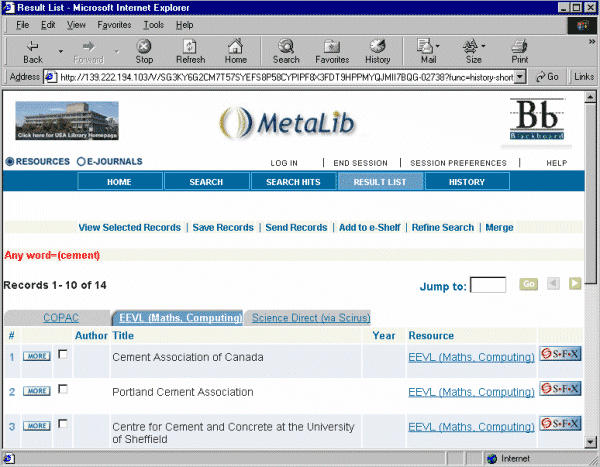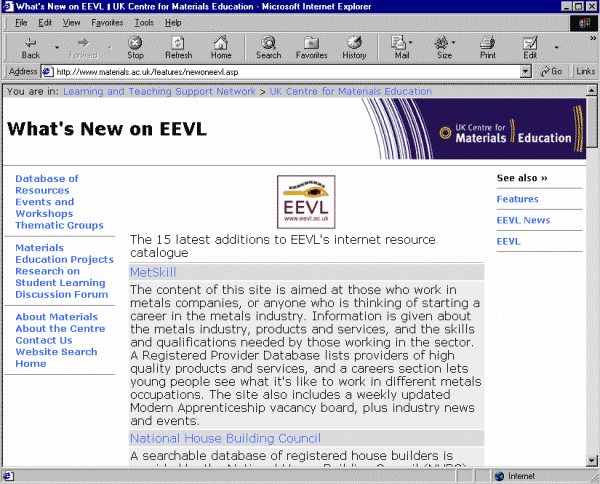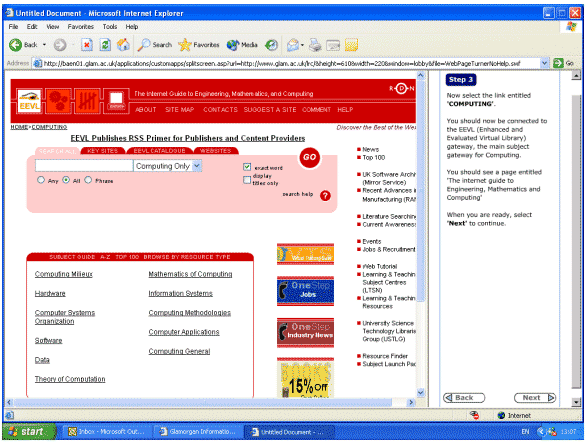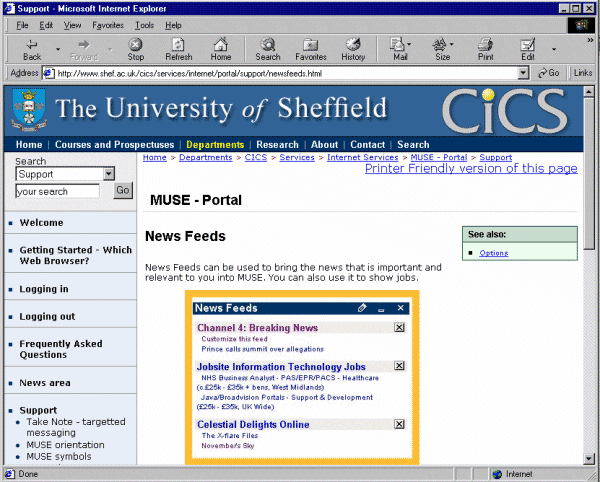EEVL News: EEVL, VLEs, Institutional and Library Portals
EEVL is the Internet guide to Engineering, Mathematics and Computing. It is an award-winning free service, which provides quick and reliable access to the best engineering, mathematics, and computing information available on the Internet. It is created and run by a team of information specialists from a number of universities and institutions in the UK, lead by Heriot Watt University. EEVL helps students, staff and researchers in Higher and Further Education, as well as anyone else working, studying or looking for information in Engineering, Mathematics and Computing. It is funded by the Joint Information Systems Committee (JISC) through the Resource Discovery Network (RDN).
What are VLEs, Institutional Portals and Library Portals?
The term Virtual Learning Environments (VLEs) is used to describe 'online interactions of various kinds which take place between learners and tutors' [1]. VLEs typically comprise a range of tools and features that aim to facilitate teaching and learning, (e.g. delivery of learning materials, on-line assessment, communication and collaboration tools, etc). One aspect of VLEs which is particularly relevant to RDN services is that they are often used to link to further resources which are available online.
The JISC FAQ on portals [2] provides concise answers to many common questions relating to portals and defines an institutional portal as providing:
'a personalised, single point of access to the online resources that support members of an institution in all aspects of their learning, teaching, research and other activities. The resources may be internal or external and include local and remote 'information resources' (books, journals, databases, Web-sites, learning objects, images, student information systems etc.), 'transaction-based services' (room bookings, finance, registration, assignment submission, assessment, etc.) and 'collaborative tools' (calendars, email, chat, etc.)'
A library portal can be thought of as providing users with a single point of access to high quality information resources. As such, Cox [3] describes the core functions of library portals as providing cross searching of multiple resources and linking to 'appropriate copy' via the use of Open URLs. Popular commercially available library portal products include Metalib [4] from Ex Libris, Fretwell-Downing's ZPortal [5] and Endeavor ENCompass [6].
Actual interoperability between systems at the library, institutional and learning environment level is currently in a fairly embryonic state [7]. Much useful work is ongoing in this area and projects such as COLIS (Collaborative Online Learning & Information Services) [8] are illustrating some of the benefits closer standards-based integration may bring.
EEVL's policy on VLEs and portals is clear: EEVL functionality may be freely reused or embedded in VLEs or portals of UK HE and FE institutions for the purposes of enhancing teaching, learning or research. Institutions using EEVL functionality in this way are simply asked to provide notification of their intended mode of use to help usage monitoring. Use for commercial purposes is via prior written agreement only.
The remainder of this article considers why EEVL resources may be useful to those searching for material to use in VLEs or portals and also provides some examples of how EEVL functionality can be used within such environments.
Why use EEVL resources?
Why use services such as EEVL to locate resources? What is wrong with simply using a search engine? The short answer is that there is nothing wrong with search engines but they are a very different sort of tool from subject gateways. Automatically created search engines (such as Google or Alta Vista) aim to index indiscriminately the full text of all the Web pages and documents available. Gateways are hand-crafted collections of only selected high quality resources; (EEVL's Internet Resource Catalogue (IRC) currently has over 10,000 resource descriptions). They are different tools suitable for different jobs.
Markland [9] recently conducted research exploring what kinds of resources lecturers were selecting for use in their VLE courses and how these resources were actually discovered. Most lecturers in the study were familiar with JISC resources and 'found much to praise especially the Resource Discovery Network'. The Virtual Training Suite (VTS) tutorials were also singled out as valuable resources by a number of lecturers. The most popular means of locating suitable online resources were reported to be via conducting Web searches or by recommendations from teaching colleagues. A number of difficulties were raised regarding the selection and use of online resources by lecturers including the lack of suitable online materials, the impermanence of Web sites and 'content churn'. These lecturers were also aware that many of their students experienced difficulty when selecting materials for projects and coursework. This was attributed to the sheer volume of materials combined with student's poor information-seeking behaviour and evaluation skills.
EEVL and the other subject gateways of the RDN offer some significant advantages over search engines for staff trying to locate suitable online resources. The resources in these catalogues have already been assessed by subject experts as being of suitable quality for HE and FE audiences. The resources have been described and catalogued by subject and by resource type in order to facilitate their discovery. The currency of the links and descriptions are regularly checked to ensure that they are up to date and that the resources are actually available. As such the catalogues offer a more reliable source of suitable materials for staff and students alike. For example, students can browse EEVL to find only the best Web sites in their subject area, and lecturers can search for quality learning and teaching materials which have been evaluated by academic staff. Clearly, the depth of coverage of subject gateways can never hope to rival that of search engines that index billions of pages, and while EEVL has attempted to tackle this issue by the creation of focused subject-specific search engines, suggestions [10] for new resources which could be included in EEVL are always welcomed.
Using EEVL Functionality in VLEs and Portals
There are a number of ways in which EEVL resources and services could be used in VLEs or portals. These range from incorporating EEVL's search facilities, to using the EEVL service as part of a learning activity within a VLE. Some illustrative examples of how EEVL might be used in VLEs and portals are provided below. Technical details for some of these options are provided in the 'Working with EEVL' [11] pages.
1. Providing EEVL search facilities
Providing search facilities within a VLE or portal may be a useful means to facilitate discovery of quality-assessed resources from within an institutional environment. Essentially this provides VLE or portal users with a collection of online resources of guaranteed quality, availability and reliability. At the simplest level an EEVL search box can be added to pages using a small piece of HTML. Figure 1 illustrates the use of the EEVL search box by the Institution of Electrical Engineers. In this scenario, search results are returned within the EEVL interface rather than the VLE or portal interface in which the EEVL search box is embedded.

Figure1: EEVL Search box in use on the Institution of Electrical Engineers site
More sophisticated means of integration can be achieved by using the Z39.50 Information Retrieval protocol [12] to search the EEVL Internet resource catalogue. Figure 2 illustrates searching of EEVL within Metalib at the University of East Anglia. Here, search results are presented without users having to leave the native interface used by the institution.

Figure 2: Search of EEVL within Metalib at the University of East Anglia
In the future EEVL plans to provide a public SOAP [13] search interface to the Internet Resource Catalogue. The SOAP interface will be based on Search Retrieve Web (SRW) [14].
2. Embedding the latest EEVL News and resources via RSS
RSS [15] is an XML-based format for sharing content, such as news headlines, on the Web. RSS is essentially data without any formatting which makes it possible to embed an RSS 'channel' containing headlines readily into a Web site, portal or VLE. EEVL currently produces nine different RSS channels, which cover new resources and learning materials for Engineering, Mathematics and Computing, as well as the latest EEVL news headlines. By using any of these RSS channels sites can easily present a subset of EEVL's resources within their preferred environment, allowing users to monitor new resources which may be of interest in their subject area. In Figure 3 EEVL's RSS feed of new resources is being used by the LTSN Centre for Materials Science and Engineering to display a listing of new resources relevant to their subject area.

Figure 3: LTSN Centre for Materials Science and Engineering using an EEVL RSS feed to display new resources
While the EEVL RSS feeds described above have proved popular, EEVL plans to expand the range of RSS Feeds produced by allowing users to create feeds based on search terms or individually selected records. This will allow lecturers to hand-pick items from the EEVL catalogue, which could then be embedded in a VLE via RSS.
3. Embedding training and learning materials
The Virtual Training Suite [16] produced by EEVL and the other RDN services offer a set of free online tutorials designed to help students, lecturers and researchers improve their Internet information literacy skills. A number of tutorials are available covering specific subject areas such as Construction, Engineering and Mathematics. Guidelines [17] are available for including the best means of including VTS materials within Virtual Learning Environments.
The University of Glamorgan has made use of EEVL for training and learning in another context (Figure 4). Here EEVL has been used within a VLE as part of a learning activity aimed at developing online information skills of students. Learners are guided in a stepwise manner through a set of tasks using the EEVL catalogue for resource discovery.

Figure 4: Using EEVL as part of a learning activity exercise within a VLE at University of Glamorgan
4. Finding relevant subject-specific news
Services such as EEVL's OneStep Industry News and OneStep Jobs [18] can assist portal developers by acting as a 'shop window' for subject-specific resources which may be suitable for embedding into their portals. For example, MUSE, the institutional portal at the University of Sheffield, has been designed to give students and staff personalised access to the University's online resources. Among the features on offer is an RSS Newsfeed facility which allows users to customise the news they wish to view within the portal (Figure 5). EEVL's OneStep services, which collect together RSS feeds on a subject-specific basis, have been recommended to MUSE portal users as starting points for discovering relevant news or job feeds as these can currently be difficult to locate by other means.

Figure 5. Muse Portal at University of Sheffield which offers RSS Newsfeed facilities
Conclusions
EEVL is striving to unbundle functional components from the current user-oriented EEVL Web site in order to provide the means by which elements may be usefully deployed at the institutional level in portals and VLEs. Due to the nature of such environments, which are often password-protected, the effectiveness and usefulness of such efforts is not always simple to measure. We are keen to engage with those involved in portal/VLE development and welcome ideas for future developments or collaborations.
References
- MLEs and VLEs explained http://www.jisc.ac.uk/index.cfm?name=mle_briefings_1
- Portals: Frequently Asked Questions http://www.jisc.ac.uk/index.cfm?name=ie_portalsfaq
- Cox, A. (2003). "Choosing a library Portal System". VINE: The Journal of Information and Knowledge Management Systems, 33(1), p37-41
- Metalib http://www.exlibrisgroup.com/metalib.htm
- ZPortal http://www.fdusa.com/products/zportal.html
- ENCompass http://encompass.endinfosys.com/
- Mclean, N. & Lynch, C. (2003). "Interoperability between Information and Learning Environments - Bridging the Gaps". A Joint white paper on behalf of the IMS Global Learning Consortium and the Coalition for Networked Information. http://www.imsglobal.org/DLims_white_paper_publicdraft_1.pdf
- COLIS (Collaborative Online Learning & Information Services) Project http://www.colis.mq.edu.au/
- Markland, M. (2003). "Embedding online information resources in Virtual Learning Environments: some implications for lecturers and librarians of the move towards delivering teaching in the online environment". Information Research, 8(4), paper no. 158 http://informationr.net/ir/8-4/paper158.html
- EEVL - Suggest a Site http://www.eevl.ac.uk/suggest.htm
- Working With EEVL http://www.eevl.ac.uk/workingwith.htm
- Z39.50 http://www.loc.gov/z3950/agency/
- Simple Object Access Protocol (SOAP) http://www.w3.org/TR/soap/
- Search/Retrieve Web Service (SRW) http://www.loc.gov/z3950/agency/zing/srw/
- Moffat, M. (2003). "RSS - A Primer for Publishers & Content Providers". http://www.eevl.ac.uk/rss_primer/
- Virtual Training Suite http://www.vts.rdn.ac.uk/
- Guidelines for including the RDN Virtual Training Suite within Virtual Learning Environments (VLEs) http://www.vts.rdn.ac.uk/teachers/guidelines.html
- EEVL OneStep Services http://www.eevl.ac.uk/onestep/
